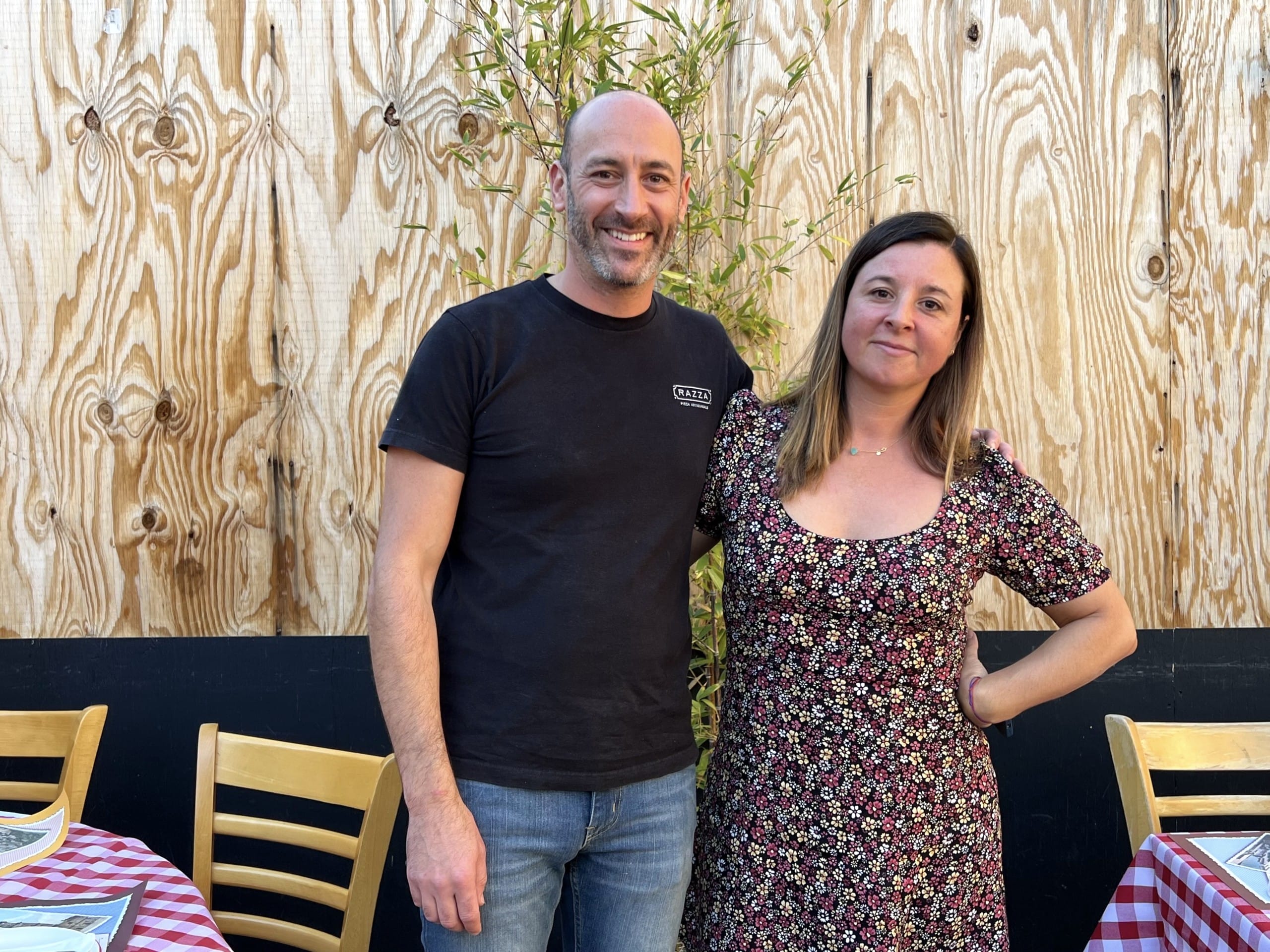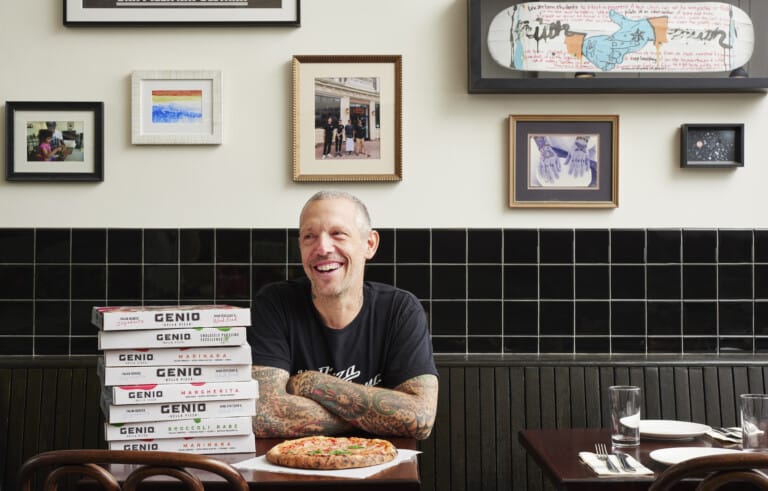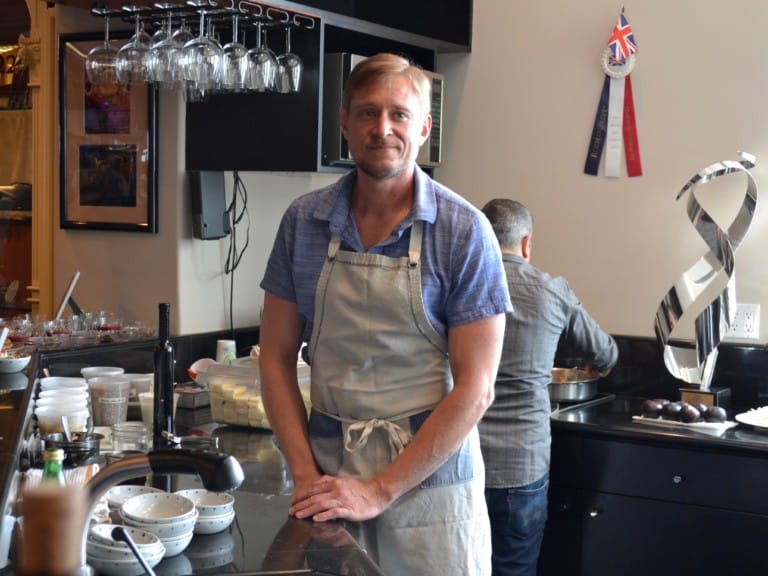INTERVIEW CONTINUED FROM PREVIOUS PAGE
JL: What was the first pizza you ever remember making, and how did it turn out? For both of you.
DR: Mine was in 2003. I was working at a restaurant and I just jumped right in there. And I ended up buying that restaurant. That was Arturo’s.
JL: How did that first pizza compare to the pizzas you’re making today?
DR: Terrible. Yeah, it was so bad. All the ingredients were not very high quality. The techniques were very poor, to say the least. The recipes were not great. Lots of commercial use sugar. There was semolina and bread flour in the dough, so it was very heavy.
JL: When did you get the sense that you could make special pizzas? At what point in your career?
DR: Right around the time that I bought the restaurant. It wasn’t doing well and the owners were done. So I ended up buying it and then changing everything one little thing at a time.
JL: When did you start making pizza, Katie?
KP: 2006. I’d taken a pizza al taglio course, the sheet pan pizza. I followed the recipe for the quantities of flour and water and consulted everything, but I used an einkorn flour, which you can’t just throw in. It makes a dense, messy – it’s like an 80% hydration dough – so instead of learning the basics, I’m like, let me do the super advanced thing that I don’t even understand. And I remember I posted it. At the time, there wasn’t Instagram, so I posted on Twitter and people ridiculed me for it. And I’m like, okay, this world is weird. But then I never posted another pizza I made until I figured out more things.
JL: When was that?
KP: Probably like 2019 or so. People on the internet are mean.
JL: Traumatic.
DR: Yeah. I’m very lucky that I opened my first restaurant before any social media because it’s very difficult to grow organically and learn as you’re constantly being judged.
JL: There are a few foods that people really have strong opinions about.
DR: Very strong.
JL: Like barbecue and pizza, in particular.
DR: Totally.
JL: How would you describe your pizza style? And how did you settle on that style?
Richer: It’s hard to define, I just say it is American artisanal pizza. There’s really no style or we’re not after authenticity by any means. I came up with our pizza slowly over time by defining the individual characteristics that I was looking to eat in my pizza. I wanted to be able to pick it up with my hands and have it be structurally sound enough for it to be picked up. It’s not like a fork and knife thing. I wasn’t interested in making Neapolitan pizza ever. I didn’t grow up in Naples. I grew up in New Jersey eating crispy pizza that you pick up with your hands. I wanted there to be an audible crunch when you bite into it. I want it to be crispy. I wanted the cheese to be fully melted and the sauce to be bright and acidic, but also sweet. With a natural sweetness. Not sugary sweet.. And that list of characteristics ended up being 56 characteristics as of today. And that’s what our book is based on.
JL: How in sync were you the two of you and your views on pizza when you started writing the book?
KP: Very.
DR: Yeah, no friction. Zero.
JL: When you visit a pizzeria to eat pizza, what are the criteria you’re using to evaluate what you’re eating?
DR: I have one. Did the person who was making it actually care? Do you feel the care and the love in that pizza? That’s it.
KP: I think about pizza all the time. I’m obsessed with it. And I end up going out to eat with people who aren’t the same way. And I end up eating some really bad pizza. But in the end, it’s less about everyone flawlessly executing or following trends, but are they, like, supporting their family making that pizza? They might not be super thoughtful about the ingredients, but that doesn’t mean they’re going to get there.
JL: Where are we at as a culture in terms of understanding pizza?
KP: Year zero.
DR: It’s the big question. I think pizza as a whole is getting a lot better as the availability to information increases. Now you can learn about sourdough from masters on YouTube. You source ingredients from around the world, and you can have access to the best tomatoes or cheese in the world. And you can taste it, and if you like it, well that’s the tomato or cheese that you should use, right? I think the access to information and ingredients has changed a lot since I started.
KP: I think there’s still a long way to go.
DR: Oh yeah.
KP: Because marketing is a really powerful thing and living in Italy I am surrounded by all sorts of messaging about the quality of the tomatoes and the type of flour and and these types of things which are reflective of a marketing campaign and not actually the true quality of a product. So yeah, we got to get more people to read this book so they could start reflecting on why you don’t have to have 00 flour. Why you don’t have to use Italian tomatoes and while you probably shouldn’t.
DR: Long way to go, but we’ve come a very long way, especially since I started. I made my first pizza in 2003, like I said. You couldn’t get San Marzano tomatoes back then. Or if you could, you had to find them.
JL: I don’t want to be too general about the Italian view of American pizza, but obviously American pizza has never been better.
KP: Yeah. I think people are starting to know that. Five years ago, Italians weren’t doing all of their annual classifications of pizza and there weren’t 500 Incredible pizzaioli working and improving every day. Now that is the case. We went to Franco Pepe’s Pepe In Grani, and Franco Pepe tasted the pizza baked by Sarah Minnick, who has a place called Lovely’s 50/50 in Portland and became obsessed with it and brought her to this huge pizza conference, and she blew everyone away. And I think even just one person, especially a woman making pizza, like from Oregon is using grains that no one’s ever heard of, and flours and all sorts of things that look really beautiful. That’s enough to – at least for people who are open minded – to be like, “Okay, well, maybe not all American pizza is bad,” but most Italians will tell me, like, “Pizza, you put ketchup on that?” I have to walk away. Don’t engage.
JL: I would think people like you or Anthony Mangieri or Chris Bianco, they went to make pizza in Italy, people would love it just as much.
KP: Totally. Definitely.









Leave a Comment